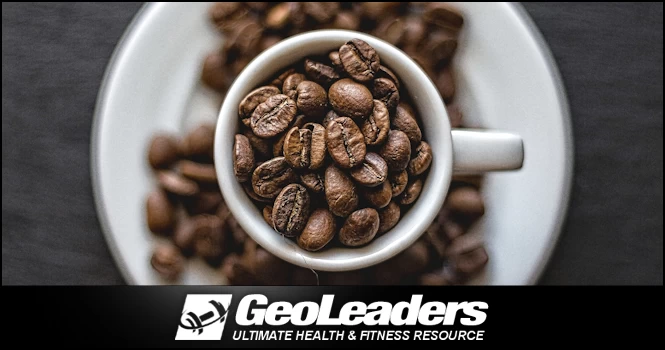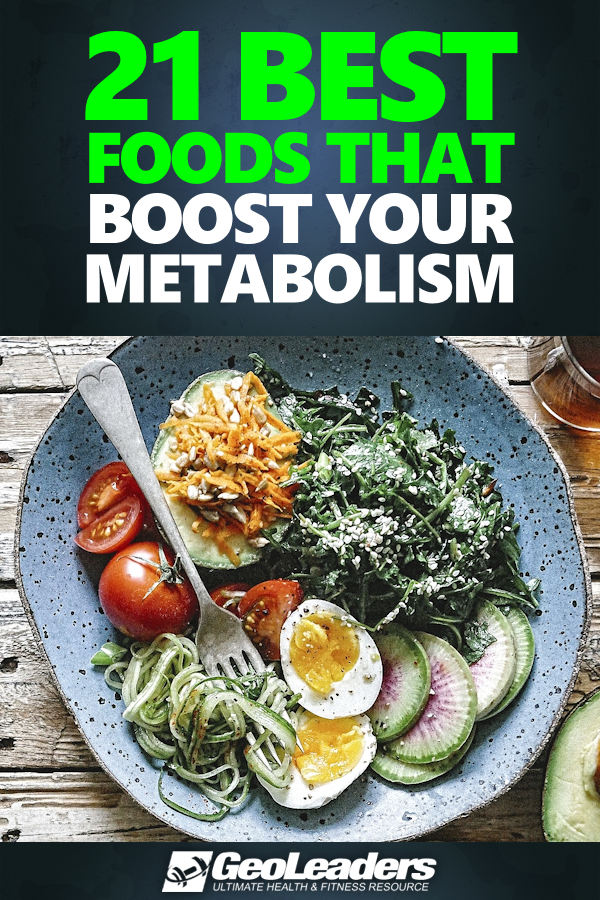What should you eat to help boost metabolism and maximize weight loss? Here are 21 science-backed foods shown to speed up your metabolic rate and burn belly fat.

Looking for the best foods to boost metabolism and burn belly fat fast?
We’ve got you covered.
Having a faster metabolism means you burn more calories, even at rest, allowing you to lose weight more efficiently.
And the good news is, you can rev up your metabolism and turn your body into a calorie-burning machine with the right diet changes.
In this nutrition guide, I’ll explain how metabolism works and list 21 of the top science-backed foods that are proven to accelerate weight loss.
With small tweaks to your diet, and by incorporating more of these metabolism-boosting superfoods, you’ll be on your way to faster fat loss results.
Ready to learn? Let’s dive in…
The Metabolism-Food Connection And How It Works
Your metabolism is comprised of a series of chemical processes that convert the food you eat into fuel and energy your body uses to function.
The number of calories your body burns each day is largely determined by your basal metabolic rate (BMR) as well as the thermic effect of food and physical activity.
BMR (Basal Metabolic Rate)
Your BMR accounts for 60-70% of the total calories you burn daily and represents the number of calories used to perform basic bodily functions like breathing, blood circulation, cell production, nutrient breakdown, and muscle contraction.
People with a faster metabolism have a higher BMR and naturally burn more calories at rest than those with a slower metabolism.
TEF (Thermal Effect of Food)
The thermic effect of food (TEF) is the number of calories burned through digesting, absorbing, and metabolizing the nutrients in your meals.
Protein has the highest TEF, requiring the most energy to metabolize compared to carbs or fat.
Physical Activity
Finally, physical activity makes up the remainder of your daily calorie expenditure through exercise, non-exercise activities like fidgeting and walking around, and muscle maintenance to preserve or build lean mass.
Exercise is one of the best ways to boost metabolism because the more active you are, the more calories you burn.
To lose weight, you need to be in a calorie deficit by consuming fewer calories than you burn each day.
Boosting your metabolic rate helps you torch more calories around the clock (even while sleeping), allowing you to create a larger deficit through your BMR rather than diet alone.
A faster metabolism also helps offset minor indulgences so occasional treats won’t derail your progress.
SAVE 20% ON OUR #1 BEST SELLING FAT BURNER!
Overall Rating: ★★★★★ (9.8)
For a limited time only, use the code LETSGO at checkout and SAVE 20% on Phentramin-D – Our #1 Best-Selling Fat Burner For Over 9 Years!
21 Metabolism-Boosting Foods Backed by Science
Now that we’ve covered the basics of metabolism, let’s get into the good stuff: 21 of the top fat-burning foods and their effects on metabolic rate, weight loss, and overall health.
We’ll also explain the science behind how these superfoods can rev up your calorie burn.
1. Green Tea
As one of the most popular metabolism-boosting beverages, green tea deserves the first spot on this list.
Its combination of caffeine and antioxidant compounds called catechins has been shown to enhance fat-burning and energy expenditure.
The main catechin responsible for these effects is epigallocatechin gallate (EGCG), which can boost metabolism by inhibiting the breakdown of norepinephrine, a hormone involved in regulating metabolic rate through the sympathetic nervous system.
Multiple studies demonstrate that drinking green tea or supplementing with green tea extract containing EGCG can increase calorie burn by 4-5% over 24 hours.
Green tea also has a synergistic effect when combined with caffeine to boost metabolism, providing an extra lift when paired together.
Just avoid drinking it too close to bedtime since caffeine can disrupt sleep. To maximize the benefits, sip 2-3 cups of unsweetened green tea per day.
2. Chili Peppers
Turn up the heat on your metabolism with chili peppers!
These spicy fruits contain a compound called capsaicin that has thermogenic properties, meaning it increases body heat production and calorie burn by activating brown adipose tissue (BAT) [1].
BAT is a special type of fat that generates heat by burning calories, unlike white fat which stores calories.
Research finds that consuming capsaicin both acutely and regularly promotes fat oxidation and stimulates BAT activity and blood circulation.
Capsaicin may also suppress appetite by reducing levels of the hunger hormone ghrelin.
Try adding chopped chili peppers to your eggs, soups, stir-fries, and other dishes or opting for spicy salsa over mild to give your metabolism a swift kick.
3. Whole Grains
Switching from refined grains to nutrient-dense whole grains does your body good in many ways, including ramping up your metabolism.
Whole grains like oats, brown rice, quinoa, and barley are rich in fiber and complex carbohydrates that take more time and energy for your body to break down.
Fiber is incredibly important for metabolism and weight control.
Insoluble fiber from whole grains passes through the GI tract undigested, adding bulk that speeds up transit time and reduces calorie absorption.
Soluble fiber feeds healthy gut bacteria that generate short-chain fatty acids that regulate metabolism.
Eating fiber-rich whole grains leads to greater satiety after meals and lower overall calorie intake.
Studies show that for every 10 grams of fiber consumed daily, your BMR increases by 30 calories.
Aim for at least 25-35 grams of fiber from whole grain carbs each day for optimal metabolic health.
4. Lean Proteins
Protein requires the most energy to digest and metabolize out of all the macronutrients.
Referred to as the thermic effect of food (TEF), protein has an estimated TEF of around 20-30% whereas carbs and fats are only 5-15%.
Therefore, eating protein-rich foods is one of the best ways to boost your metabolism over other foods.
Protein is also essential for building and maintaining muscle mass since amino acids are the building blocks of muscle tissue.
The more muscle you have, the higher your BMR becomes because skeletal muscle burns more calories around the clock than fat tissue.
Some top high-protein foods recommended for faster metabolism include skinless poultry, fish and seafood, eggs, lean beef and pork, Greek yogurt, beans and legumes, nuts, seeds, and low-fat dairy.
Shoot for 0.5-1 gram of protein per pound of body weight distributed throughout your day.
5. Greek Yogurt
Greek yogurt is truly a metabolic superfood.
First, it provides an excellent source of high-quality protein to help build muscle and balance blood sugar.
Second, it contains probiotics that promote healthy gut flora linked to normal BMI and weight maintenance.
Studies demonstrate yogurt consumption is associated with lower body weight, smaller waist circumference, and reduced body fat compared to non-yogurt eaters.
Greek yogurt specifically can enhance your ability to burn fat thanks to its strained process that removes excess liquids and carbohydrates, concentrating the protein.
Enjoy 2-3 servings of probiotic-rich Greek yogurt per day by itself as a snack, with fruit, in smoothies, or as a substitute for sour cream, mayo, or cream cheese in recipes.
Just be mindful of the sugar content in flavored yogurts.
6. Berries
All types of berries can be the best foods for weight loss, chock-full of healthy antioxidants and fiber while being low in sugar.
Specific antioxidants found abundantly in berries called flavonoids and anthocyanins have anti-inflammatory effects that may protect against obesity.
Some research on blueberries shows their polyphenols can increase fat breakdown and alter the expression of genes involved in fat metabolism and storage.
The fiber and water content in berries supports satiety as well by slowing digestion and hydrating the body.
Add a daily serving or two of mixed berries onto yogurt, oatmeal, or salads, or simply eat them plain for a sweet treat.
You can also try berry smoothies and chia puddings for extra metabolism and weight loss benefits.
7. Citrus Fruits
Brighten up your meals with citrus fruits like oranges, grapefruit, lemons, limes, and tangerines.
They are very low in calories while providing filling fiber, disease-fighting vitamin C, and antioxidants that make them staple metabolism boosters.
Research suggests citrus fruits may enhance fat burning thanks to flavonoids like naringin and naringenin they contain [2].
These compounds are shown to stimulate AMPk, an enzyme involved in metabolic processes that increase fatty acid oxidation.
Some compounds in citrus peels may also limit fat accumulation.
Beyond their metabolism-boosting abilities, eating citrus fruits is associated with a lower risk of obesity and heart disease, making them a smart weight loss choice.
Enjoy citrus fruits eaten whole, juiced, in salads and marinades, or blended into smoothies.
8. Leafy Greens
Stock up on leafy greens like spinach, kale, romaine, arugula, Swiss chard, and collard greens if you want to fuel your metabolism and weight loss.
These low-calorie vegetables provide nutrients that help cleanse your body and fire up your metabolism, especially vitamin K, folate, magnesium, and zinc.
Leafy greens help optimize thyroid function, and the thyroid gland directly controls metabolic rate and weight regulation.
Greens also contain nitrates that expand blood vessel diameter and increase blood flow and oxygen delivery to muscles, boosting metabolism during exercise.
Aim for at least 2-3 servings of leafy greens per day added to meals and snacks.
They make great additions to omelets, salads, sandwiches, soups, and smoothies.
9. Nuts and Seeds
Don’t be afraid to incorporate nuts and seeds into your diet if you want to lose weight faster.
Despite being high in fat and calories, the monounsaturated and polyunsaturated fatty acids found in nuts and seeds are linked to increased calorie burn, according to research.
The fiber, protein, and nutrients like magnesium found in nuts and seeds help regulate appetite hormones, promote satiety, and prevent overeating.
Just be mindful of portion sizes as too many can lead to excess calories.
Stick to 1-2 servings per day of nuts or seeds paired with fruit, oatmeal, salads, or eaten alone as snacks.
Some of the top options for metabolism include almonds, walnuts, pumpkin seeds, sunflower seeds, flaxseeds, chia seeds, and peanuts.
10. Eggs
Eggs check off all the boxes for a metabolism and weight loss superfood.
They provide high-quality protein for building muscle mass, amino acids to balance blood sugar, and nutrients choline and selenium that are essential for a healthy metabolism.
Studies prove that starting your day with eggs enhances weight loss compared to a bagel breakfast matched for calories.
The protein in eggs helps you feel fuller for longer, reducing calorie intake later in the day.
Eggs can promote fat burning as well – a study found people who ate eggs instead of bagels had an elevated TEF response after eating.
Enjoy eggs any way you like – scrambled, over easy, hard-boiled, omelets, etc. Most healthy adults can eat 1-2 whole eggs per day as part of a balanced diet.
11. Legumes
Get to know legumes if you want to shed pounds.
Foods like beans, lentils, chickpeas, and peas are packed with protein, fiber, and resistant starch that supports weight control in multiple ways.
The high fiber content of legumes feeds healthy gut bacteria and adds bulk to your stool to minimize calorie absorption from food.
Resistant starch resists digestion, acting more like insoluble fiber, and triggers the release of satiety hormones in the gut.
Research shows greater bean intake is associated with lower body weight and body fat, smaller waist circumference, and reduced risk of obesity.
Aim for 1⁄2 cup of legumes daily added to soups, stews, salads, or grain bowls.
12. Fatty Fish
Fatty fish like salmon, mackerel, sardines, trout, herring, and tuna are true metabolism heroes.
They provide high-quality protein for muscle building and are rich in omega-3 fatty acids that increase fat burning by reducing chronic inflammation.
Multiple studies demonstrate greater intake of omega-3s from fish oil or fatty fish is associated with reductions in body fat, waist circumference, and appetite.
Omega-3s enhance fat oxidation after meals and increase enzymes involved in fat breakdown in fat tissue.
Aim to incorporate at least 2-3 servings per week of fatty fish like salmon or tuna.
Other oily fish are great choices as well.
Grilling, baking, or pan-searing are healthy cooking methods to try.
13. Apple Cider Vinegar
Tart, tangy apple cider vinegar has gained popularity as a metabolism booster and weight loss aid.
Acetic acid, the active compound in vinegar, seems to have anti-obesity effects.
Research shows vinegar consumption increases satiety and fullness, leading to reduced calorie intake.
Vinegar may also minimize fat accumulation, amplify fat burning, and preserve metabolism-revving muscle mass according to some animal studies.
However, the mechanisms are still not fully understood in humans. Start by adding 1-2 teaspoons of apple cider vinegar to salads or diluting in water to drink.
14. Coconut Oil
Coconut oil has a unique composition of medium-chain triglycerides (MCTs) that enhance metabolism compared to longer-chain fats.
MCTs, otherwise known as medium-chain fatty acids, are easily digested and sent straight to the liver to be turned into energy.
Studies estimate MCTs may increase calorie burn by 120-250 calories per day.
Coconut oil consumption seems to boost abdominal fat loss more than other types of fat.
Animal research also finds it does not promote weight gain and may stimulate fat browning.
Use coconut oil instead of other oils when cooking and baking.
15. Avocado
Don’t fear healthy fats from foods like avocado for faster weight loss.
Though high in calories, avocados contain monounsaturated fats shown to improve lipid profiles and reduce cholesterol without leading to weight gain.
One study found swapping saturated fat with olive or avocado oil led to lower BMI and abdominal fat.
Avocado is very satiating thanks to its fiber content, enhancing post-meal fullness and curbing overeating at later meals.
Another advantage is that an avocado also contains a rare carbohydrate known as Mannoheptulose, helping to lower the secretion of insulin [3].
Other research in overweight adults found eating avocado daily led to significantly greater fat loss than a control diet with minimal avocado.
16. Garlic
Garlic is a flavorful, low-calorie food packed with health benefits.
The bioactive compound allicin in garlic may regulate genes involved in fat metabolism, suppress fat accumulation, and trigger fat loss, according to animal research.
Garlic also provides prebiotic fiber that nourishes good gut bacteria tied to normal body weight and composition.
Adding generous amounts of minced or crushed garlic to savory dishes enhances flavor without added calories.
Garlic lovers can also take supplements for concentrated benefits.
17. Turmeric
The golden spice turmeric contains an active compound called curcumin that demonstrates anti-obesity activity in research.
Studies indicate curcumin may increase fat burning, suppress new fat cell formation, and decrease the size of fat tissue.
The anti-inflammatory, antioxidant, and blood sugar-regulating properties of curcumin also make it a go-to metabolism booster.
Use turmeric liberally when cooking curry dishes, grain bowls, vegetables, eggs, and more. Curcumin supplements are another option.
18. Ginger
Like other spices, ginger can give your metabolism a lift thanks to two unique compounds called gingerols and shogaols that accelerate thermogenesis [4], [5].
Consuming ginger is shown to increase calorie burn by boosting blood circulation, raising body temperature, and activating brown fat activity.
Ginger also helps control appetite by slowing gastric emptying and regulating key hormones.
Fresh or dried ginger adds major flavor to stir-fry dishes, marinades, dressings, herbal tea, and more without added calories.
19. Dark Chocolate
Indulge in the sweet taste of dark chocolate without guilt – cacao contains flavanols shown to boost metabolism by encouraging cells to expend more energy (calories).
Dark chocolate also improves satiety by regulating hunger hormones like ghrelin.
In 2007, a study was conducted to evaluate the effects of Cacao extract on subjects suffering from Type 2 Diabetes.
According to the study, the researchers concluded that the dietary consumption of cacao products or beverages manufactured from cacao beans may help to prevent the development of Type 2 Diabetes [6].
Stick to 1-2 ounces of dark chocolate with at least 70% cacao daily.
20. Cinnamon
Cinnamon is a versatile and antioxidant-rich spice that helps control blood sugar spikes, which in turn regulates fat metabolism.
It contains active compounds that mimic insulin, improving glucose uptake in cells for energy production.
Research also demonstrates cinnamon can support weight loss by reducing plasma glucose levels, boosting metabolism, and increasing satiety.
Mix 1⁄4 to 1 teaspoon of cinnamon into your coffee, oats, baked goods, or smoothies.
21. Spinach
This leafy green vegetable is brimming with iron and magnesium, two critical nutrients for energy production that keep your metabolism humming.
Spinach is also very low in calories, allowing you to fill up on a large portion.
Studies found higher intakes of iron and magnesium are associated with lower risk of metabolic syndrome and Type 2 diabetes – two risk factors for slow metabolism.
Add a cup or two of spinach to your salads, scrambles, and smoothies to rev up calorie burning.
Transparency Disclosure: Some of the links in this post are affiliate links. This means we may make a small commission on purchases at no extra cost to our readers.
How to Incorporate Metabolism-Boosting Foods
While the metabolism-enhancing foods listed here are highly beneficial, it’s important not to go overboard on any single one.
The key is incorporating a variety of these foods into a balanced, nutrient-rich diet across all the food groups.
Aim for a mix of lean proteins, fiber-rich fruits, vegetables and whole grains, healthy fats, and low-fat dairy.
Fill half your plate with non-starchy veggies and fruit at each meal.
Moderate portions of whole grains, proteins, legumes, nuts, seeds, and healthy oils make up the other half.
Stay hydrated by drinking water, tea, or coffee.
Food Combinations To Boost Metabolism
For balanced meals and snacks, try combinations like:
- Greek yogurt with berries, chia seeds, cinnamon and almonds
- Omelet with veggies, avocado, and salsa
- Tuna, cannellini bean, and spinach salad with balsamic vinegar
- Turkey burger on a whole wheat bun with roasted sweet potato fries
- Quinoa veggie bowl with beets, peppers, chickpeas, and tahini dressing
- Overnight chia oats with almond milk, nuts, and apples
- Edamame hummus with carrots, cucumbers, and sprouted whole-grain toast
How To Maximize The Metabolism-Enhancing Effects
To get the most out of adding these foods to your diet, keep these tips in mind:
- Maximize TEF: Combine proteins, carbs, and fats in meals and snacks to maximize TEF
- Meal Timing: Time your metabolism-boosting foods before and after exercise when your metabolism is elevated
- Green Tea: Drink green tea between meals to prolong thermogenesis from a previous meal
- Raw Foods: Choose raw fruits and veggies rather than cooked to preserve more nutrients
- Vinegar Dressings: Opt for vinegar-based dressings and marinades on salads and proteins
- Proper Hydration: Stay hydrated with water to optimize metabolism – shoot for half your body weight in oz.
- Aim For Variety: Include a variety of foods that speed up metabolism in each meal for synergistic effects
- Adequate Sleep: Manage stress and get at least 7-9 hours of quality sleep nightly
- Consistent Exercise: Engage in regular exercises like cardio, strength training, and HIIT to build muscle
- Regular Meals: Avoid extended periods without eating to prevent metabolic slowdowns
Metabolic Differences Between People
Every person’s metabolism is unique based on a combination of genetic and lifestyle factors.
Metabolism refers to all the chemical processes in the body that convert food into energy. People who naturally have faster metabolisms tend to burn more calories at rest and during activity.
Genetics can play a role in metabolic rate, but other factors like age, sex, body size, and composition also impact how quickly calories are burned.
Generally, men have faster metabolisms than women due to greater muscle mass and hormone differences.
Metabolism slows down with age as muscle mass decreases and physical activity levels decline.
While genetics set a baseline for metabolic rate, many lifestyle habits can significantly influence your metabolism throughout life.
Diet, exercise, stress, sleep, and medical conditions all affect metabolic function.
The good news is you can take active steps to counteract a slower metabolism through strategic nutrition and lifestyle changes.
Metabolism And Weight Loss Myths
When it comes to metabolism and weight loss, some common misconceptions need debunking:
Myth: Faster metabolism always means easier weight loss.
Fact: Metabolism is just one small piece of the weight loss puzzle. Creating a sustained calorie deficit through diet and exercise is what matters most for fat loss, regardless of metabolic rate. Someone with a slower metabolism can still lose weight by eating in a deficit.
Myth: You need three meals a day to “stoke” your metabolic fire.
Fact: Total daily calorie intake is more important than meal frequency for metabolism and weight loss. Eating more frequent, smaller meals does not necessarily boost calorie burning.
Myth: Strength training is ineffective for weight loss compared to cardio.
Fact: Strength training is incredibly beneficial for weight loss by building calorie-burning muscle mass, boosting metabolism, and improving body composition.
Myth: Metabolism stops working after age 40.
Fact: While metabolism gradually slows over time, adults can still build muscle mass and lose weight in a healthy, sustainable way at any age through diet and exercise.
Considerations With Metabolism-Boosting Foods
While the foods mentioned in this article are considered healthy, a few things to keep in mind:
- Don’t go overboard on any single food or ingredient to avoid nutritional imbalances. Variety and moderation are key.
- Spicy foods may cause gastrointestinal discomfort in some people. Drink plenty of fluids and reduce portion sizes if this occurs.
- High-fiber foods may cause initial gas or bloating as your body adjusts. Increase slowly over time.
- Caffeine should be limited to no more than 400mg daily to prevent any potential side effects like nausea, anxiety, and rapid heartbeat.
- Foods are not quick fixes – they support metabolism and weight loss when part of an overall healthy lifestyle.
- Certain medications may interact with some foods, so always talk to your doctor about any dietary changes if needed.
Meal Plans and Dietary Patterns
Here are some examples of daily meal plans featuring a balanced mix of foods that increase metabolism:
Option 1:
- Breakfast: Veggie omelet with avocado spread on sprouted grain toast, tomato slices, and citrus juice
- Snack: Greek yogurt with mixed berries, chia seeds, cinnamon, and almonds
- Lunch: Quinoa salad with kale, chickpeas, beets, sunflower seeds, and lemon vinaigrette
- Snack: Tuna-stuffed avocado with hot sauce
- Dinner: Chicken stir fry with peppers, broccoli, carrots, garlic, and ginger over brown rice
Option 2:
- Breakfast: Overnight oats made with steel-cut oats, chia seeds, almond milk, coconut, banana, and almonds
- Snack: Cottage cheese with pineapple, peppers, and pumpkin seeds
- Lunch: Grilled salmon salad with spinach, sweet potato, avocado, pepitas, and balsamic dressing
- Snack: Celery sticks and chickpea hummus
- Dinner: Turkey meatloaf with roasted Brussels sprouts and sweet potato fries
Other Supportive Lifestyle Habits
Along with a metabolism-friendly diet, other habits that encourage weight loss include:
- Engaging in regular aerobic and strength training exercises 4-5 times per week
- Establishing consistent sleep habits and getting 7-9 hours of quality sleep per night
- Managing stress through techniques like meditation, yoga, deep breathing
- Staying adequately hydrated with water throughout the day
- Avoiding extended periods of inactivity by taking movement breaks
- Eating attentively and mindfully without distractions
- Keeping well-balanced macros at each meal – carbs, protein, fat
- Practicing intermittent fasting or time-restricted feeding if desired
- Tracking intake of calories, macros, or micronutrients, if helpful
- Joining a fitness community for accountability and encouragement
The combination of optimized nutrition, physical activity, and healthy lifestyle habits is your best bet for boosting metabolism to reach weight loss goals sustainably.
Be patient and focus on consistency over time to see optimal results.
Frequently Asked Questions (FAQs) About Metabolism-Boosting Foods
Here are some of the most common questions readers have about boosting metabolism with diet and nutrition.
Q. What are the best foods that boost the metabolism naturally?
The best foods to naturally boost metabolism include lean proteins like fish, chicken, eggs, and plant-based proteins; whole grains like oats and quinoa; berries; leafy greens; healthy fats like nuts and avocado; spicy foods like cayenne and ginger; green tea and coffee.
Q. How does protein intake affect metabolic rate?
Protein requires more calories for digestion than carbs or fat which increases metabolic rate. It also builds calorie-burning muscle. Aim for 0.5-1 gram of protein per pound of body weight.
Q. Are there any plant-based protein sources that boost metabolism?
Yes, plant proteins like beans, lentils, tofu, and edamame can help boost metabolism through their high fiber content and ability to build muscle like animal proteins.
Q. What role do probiotics play in supporting metabolism?
Probiotics support healthy gut flora which is linked to normal BMI and weight maintenance. Yogurt and fermented foods contain probiotics.
Q. Can caffeine help with weight loss and increased metabolism?
Caffeine found in coffee and tea can increase metabolism and fat burning, especially when paired with catechins in green tea or chlorogenic acid in coffee.
Q. Are there specific vitamins and minerals that aid in metabolism?
Iron, iodine, selenium, zinc, chromium, and magnesium aid in metabolism regulation and energy production. Fish, greens, nuts, and seeds provide these.
Q. How can I incorporate metabolism-boosting foods into my daily diet?
Add metabolism-boosting foods to smoothies, eggs, yogurt, oats, salads, snack mixes, soups, and grain bowls for balanced meals.
Q. Do metabolism-boosting foods help with weight loss?
Yes, a diet high in metabolism-boosting foods can create the optimal conditions for weight loss through their effects on metabolic rate.
Q. Are there any metabolism-boosting foods to avoid?
Avoid refined carbs, added sugars, fried foods, processed meats, and sugary drinks as these hinder metabolism.
Q. Can a combination of these foods enhance metabolism further?
Combining proteins, fats, carbs, and antioxidants/spices can maximize the thermic effect and provide synergistic metabolism benefits.
Final Thoughts on Foods That Boost Metabolism
Losing weight can certainly feel challenging, but you have more control over your metabolic rate than you may think.
While genetics play a role, the foods you choose to eat each day have powerful effects that either speed up or slow down your calorie-burning potential.
Fill Your Diet With Metabolic Fuel
Filling your diet with whole, nutrient-dense foods as outlined here will set your metabolism up for victory. Their proteins, healthy fats, fiber, and antioxidants are proven to rev up your fat-burning engines, allowing you to finally ditch those stubborn pounds more quickly and efficiently.
Small Changes Equal Big Results
Implementing even a few of the metabolism-boosting superfoods can create the small calorie deficit needed for incremental weight loss over time. As you build momentum and confidence from seeing progress on the scale, you’ll be motivated to double down on your healthy eating habits.
It’s Not Just About Diet
Keep in mind that nutrition is just one part of the weight loss equation – regular exercise, adequate sleep, and stress management are also key pieces for optimal metabolic function and body composition. The dietary and lifestyle changes suggested here work synergistically to get your metabolism humming.
Patience and Persistence Are Key
Be patient with yourself throughout the process. Establishing healthy, sustainable habits is far more important than the number on the scale. If you consistently give your metabolism the right fuel through proper nutrition and an active lifestyle, your body will respond accordingly.
Make Food Your Metabolic Powerhouse
The daily choices we make around food have immense power to alter our health. Food provides us with energy to thrive, and our food choices directly impact the complex inner workings driving calorie burning. With a little metabolic nutrition knowledge in your toolbox, you can feel empowered to eat in a way that sustains consistent energy levels and optimizes your weight loss efforts.
SAVE 20% ON OUR #1 BEST SELLING FAT BURNER!
Overall Rating: ★★★★★ (9.8)
For a limited time only, use the code LETSGO at checkout and SAVE 20% on Phentramin-D – Our #1 Best-Selling Fat Burner For Over 9 Years!
Transparency Disclosure: Some of the links in this post are affiliate links. This means we may make a small commission on purchases at no extra cost to our readers. Thank you for your support!




